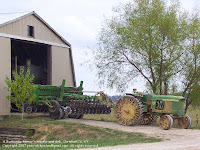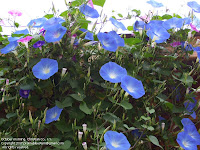Steel wheels limit contact with the world.

I drove a Mennonite neighbor lady to the dentist this morning. She was still helping in the dairy barn when I arrived to pick her up. A cow was having a calf, and things weren't going well. The vet was there to assist, and my neighbor lady was finishing up the milking while her husband helped the vet.
All ended well. Both the cow and calf should be all right, and we arrived at the dentist appointment in plenty of time.
While I was waiting for the neighbor lady to get ready, I snapped this photo of their steel-wheeled tractor, parked on the ramp to the haymow (2nd floor) of their barn. Their church rules (Wenger Mennonite) require them to use the steel wheels.
The idea behind the rule is that steel wheels prevent the tractor from becoming a vehicle for travel. While they don't see anything morally wrong with riding in cars and other motorized vehicles, they choose not to own them because vehicles decrease ties to their own community and increase ties to the world.
The steel wheels are durable, but they probably compact the soil more than pneumatic tires. They are surely rough-riding, also. Maybe that's part of the reason why many Mennonites go to the chiropractor regularly.
Steel wheels in some other Anabaptist groups
I've read that Old Order Amish farmers in some areas use steel-wheeled tractors, but all the Old Order Amish around here farm with horses. They sometimes use farm equipment that is powered by a stationary gasoline engine, but pulled through the field by workhorses. I've seen them baling hay with this sort of setup.
The New Order Amish here (Beachy Amish) have fully accepted pneumatic tires, and they do indeed use tractors as road vehicles. They usually pull an old pickup truck box that's been converted into a covered trailer. The husband drives, and everyone else rides in the trailer. The tractors go 30 or 35 mph on the highway, and they often drive them to town and all over the county.
Out in the Wichita, Kansas, area where my brother lives, some of the Mennonite groups use steel wheels that have a regular tractor tire stretched over them -- no air or fluid involved. The rubberized wheels have a bit of a shock absorber, but they still impose a physical limitation on the distance that can be traveled on them.
My brother says that sometimes "English" farmers buy the rubberized steel wheels for equipment they are going to use for brush-hogging and other rough work. (The Mennonites call us "English" because that's our main language.)
Carriage house
 I also saw these morning glories in our neighbor's yard while I was waiting this morning. The vines are growing on a nice new shed, across the driveway from the barn. The shed has a workshop on one end, and a carriage house on the other end.
I also saw these morning glories in our neighbor's yard while I was waiting this morning. The vines are growing on a nice new shed, across the driveway from the barn. The shed has a workshop on one end, and a carriage house on the other end.I had to think a while to come up with the term "carriage house" in the last paragraph. First I wrote that it was "like a carport." Then I called it "a storage area for buggies and bicycles." Next, I tried "garage." Finally, I remembered that there is a perfectly good, old-fashioned word for the shed where the buggy is kept.
Related site:
John Deere Steel Wheel Tractors
Related posts:
Mennonites and Amish in Christian County, Kentucky
Horse and Buggy Country
1 comment:
That would be some ride driving around on steel wheels all day, I've had some rough rides on the pneumatic ones but at least they have some give in the sidewalls. As for the ones that use the tractor as transport I'm not sure how they justify that as the only difference (apart from being more uncomfortable) from a car is that they travel slower but then I guess same could be said for walking or horse travel. Bob.
Post a Comment